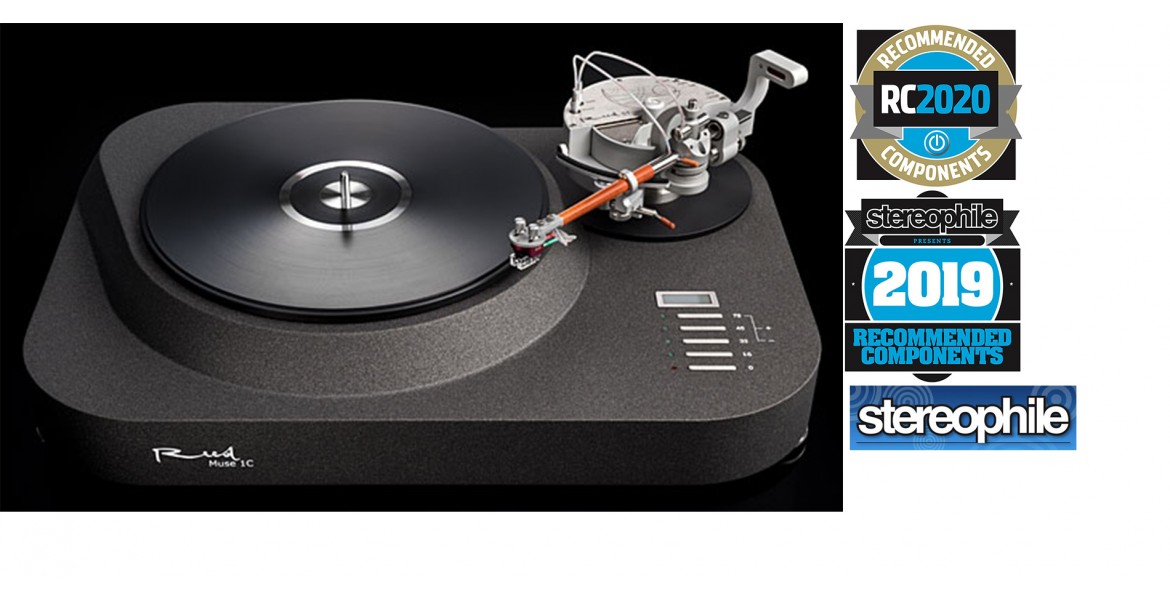

A Reed Muse 3C turntable ($20,000) with 3P tonearm ($5500 for the 9.5" version, footnote 1) sat on a display table across from us.
I'd favorably reviewed both of those products, in the Vol.39 No.4 and Vol.40 No.11 Analog Corners, and thought highly of them, but I was surprised when the manufacturer beside me mentioned that he thought they were exceptional: ingenious, well-engineered, fine-sounding, and visually appealing. It's hard to say otherwise about these Lithuanian-made products, but it's unusual for the competition to express such unreserved adulation.
"I agree!," I responded. Compared to that more costly flagship 'table, the Muse 1C ($15,000) has a larger footprint and a more traditional-looking design. It weighs less—33lb vs the 3C's 55lb—and comes in either Moonlit Black or Karelian birch finishes, instead of the 3C's machined aluminum.
The 1C is arguably more dramatic and attractive looking, though both models look snazzy, down to the thin leather/suede platter mats supplied with all Reed turntables. The 1C's drive system is derived from that of the 3C and uses the same main bearing and drive system.
Central to this is an aluminum subplatter machined with a tapered hub, driven by two opposing PLL (phase-locked loop)–controlled DC motors that turn at slightly different speeds; the two motor pulleys are fitted with rubber/ elastomer drive wheels of slightly different diameters. Unlike the 5C, which can be ordered, for an upcharge, with both dual "friction-wheel" drive and belt drive, the $15,000 1C can be ordered with either drive mechanism but not both.
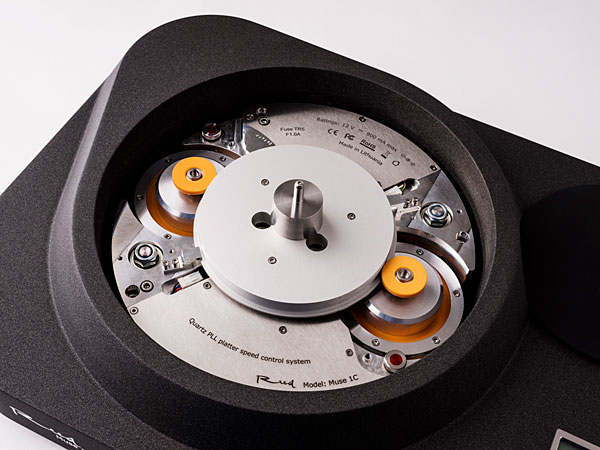
The 6lb POM platter features a large-diameter, tapered, machined-aluminum insert that fits securely over the subplatter's tapered hub to complete a stable, high-torque drive system that achieves speed quickly. The 1C plays four speeds: 16.67, 33.3, 45, and 78.
The 78rpm setting can be adjusted to between 70–85rpm to accommodate the various speeds appropriate to different 78rpm records.
Based on my Platterspeed app results (figs.1 & 2), the 1C's relatively light platter spins with impressive speed consistency.
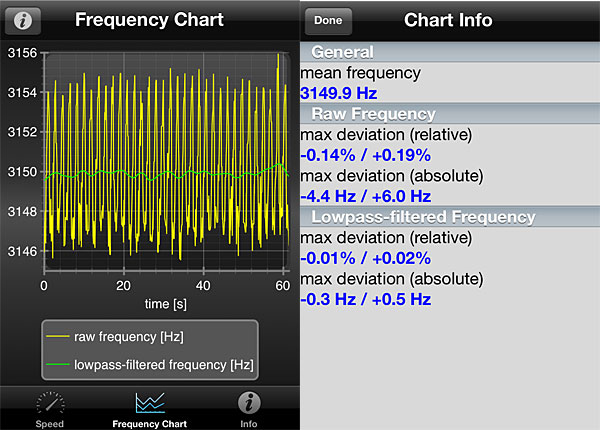
The 1C accepts only one tonearm, 9.5–12", to the 3C's two. Both models feature built-in inclinometers that allow you to easily level the 'table without using additional tools.
The pivoted, tangential-tracking 5T tonearm The Reed 5T ($21,500) is a pivoted tonearm with a unique design that enables it to track tangentially. During record playback, a laser emitter located just below the upper vertical bearing points and a Gort-like laser sensor (footnote 2) located at the rearmost part of the arm assembly are used to track the tonearm's lateral motion; that information is used to adjust, on the fly, the position of the tonearm's lateral pivot: a correction applied in real time by means of a small, battery-powered motor in the arm-mount assembly.
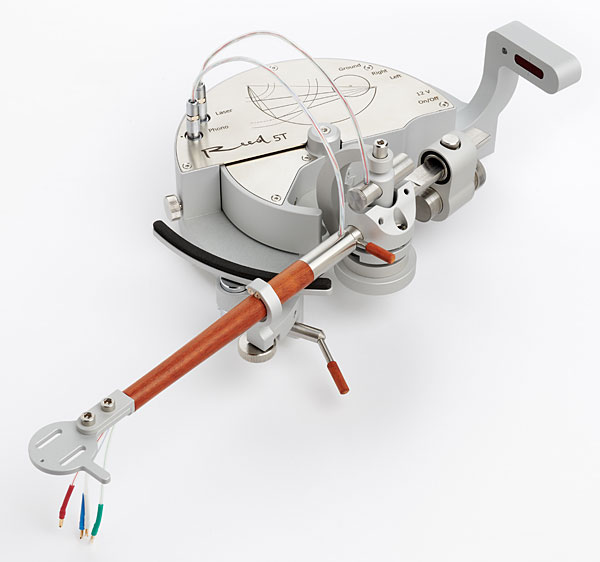
As the arm swings across the record, the player's three key points—the stylus, the tonearm pivot, and the record spindle—form a perfect right triangle in three arm positions, spaced evenly across the record's grooved area. And in each of those triangles, the stylus is at the apex of the 90° angle—and so there are three arm positions at which perfect tangency of stylus to groove is achieved, with relatively negligible lateral tracking error between those positions.
Reed says the 5T's maximum error is ±5 minutes of angle—ie, approximately 1/12 of a degree—whereas standard pivoted arms usually have tracking errors of up to 1.5°.
That's a big improvement.
This works because Reed designed their moving-pivot mechanism with Thales's theorem (footnote 3) in mind.
The illustrations shows the geometry involved. In fig.3, P1-01-P3 is the diameter of the conceptual semicircle on which Thales's theorem depends, and the triangles formed by P1-A1-P3, P1-A2-P3, P1-A3-P3 are all right triangles.
The line segments A1B1-A2B2-A3B3 represent the tonearm's wand; P2 represents the center of a circle drawn through three points—B1, B2, and B3 (the tonearm rotation axis); P3 is the linear sensor array, and B2-P3 is the laser beam. The diagram's key takeaway is that the tonearm is able to maintain the stylus with near tangency to the record grooves, not only at the three A points shown but all across the playing surface
(fig.4).
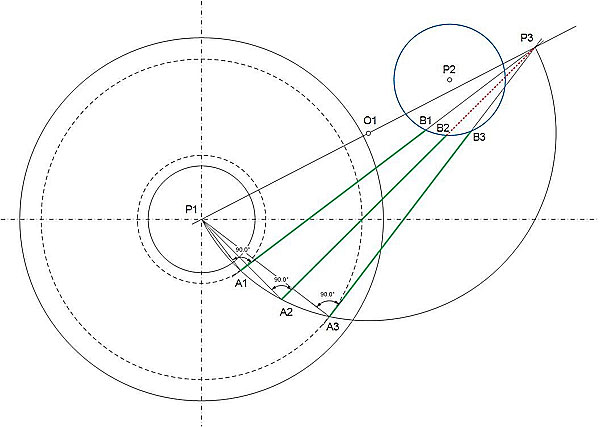
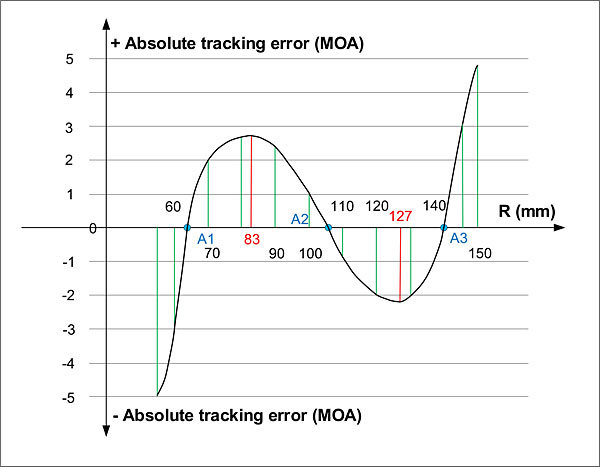
Also, compared to pivoted arms (especially unnecessarily long ones), the 5T has a smaller moment of inertia, so it tracks better.
And in addition to the minimal lateral tracking error, the 5T's tangential tracking mechanism addresses antiskating concerns. Reed claims other advantages over other companies' tangential trackers:
The Reed arm eschews air supplies and compressors, for example, and its effective mass, in both vertical and horizontal planes, is similar to that found in conventional arms. The Reed 5T is available in all-opaque silver metalwork (as supplied), in black metal, and in black with gold accents.
Wood options for the arm tubes include Wenge, Makassar Ebony, Cocobolo, and Teak (Light or Dark). The arm's $21,500 price may be steep, but once you see the 5T in operation, it becomes an object of desire. It performed flawlessly throughout the review period.
Installation and setup I have quite a lot of experience setting up tonearms, but setting this one up was an exercise in frustration, for reasons partly but not entirely my fault. Even under the best of circumstances, even the most experienced analog fans are likely to find the 5T's setup challenging. Designer Vidmantas Triukas, who is obviously a genius, apparently thinks all his buyers are geniuses as well.
The instructions do a good job of explaining certain elements of setup, such as how to use a supplied plastic alignment tool for measuring pivot-to-spindle distance.
But other topics aren't well-covered or are less than clearly spelled out. When at one point I was faced with a confusing section, I emailed the manufacturer, who sent me the URL for a video on YouTube, which should have been mentioned in the instructions.
Some setup difficulties were of my own making. I didn't read the instruction manual, as the manual itself suggests, before starting to unpack things. So when I unboxed a battery power supply, I saw it had two outputs and two umbilicals.
Was it unreasonable for me to assume, in the absence of instructions to the contrary, that one cable would power the turntable and the other the tonearm's servo? The umbilicals fit that way, after all. But it turned out the second umbilical is for powering a second arm—not the turntable—and when I plugged it into the turntable's power-in socket, I blew an exotic cylindrical fuse that looked a little like a capacitor.
With assistance from Reed, I tracked down a source for that part and ordered a replacement. Digi-Key had it delivered the next day. Here's a suggestion: Provide a separate, less-detailed document—just one sheet, placed at the top of the box's contents—that maps out a basic setup strategy, with a link to a video of the setup process. After the general approach has been grasped, more detailed, specific instructions would be helpful. Instead of telling us to be sure a bearing is in the "right" or "correct" position, please show us what position is right and correct!
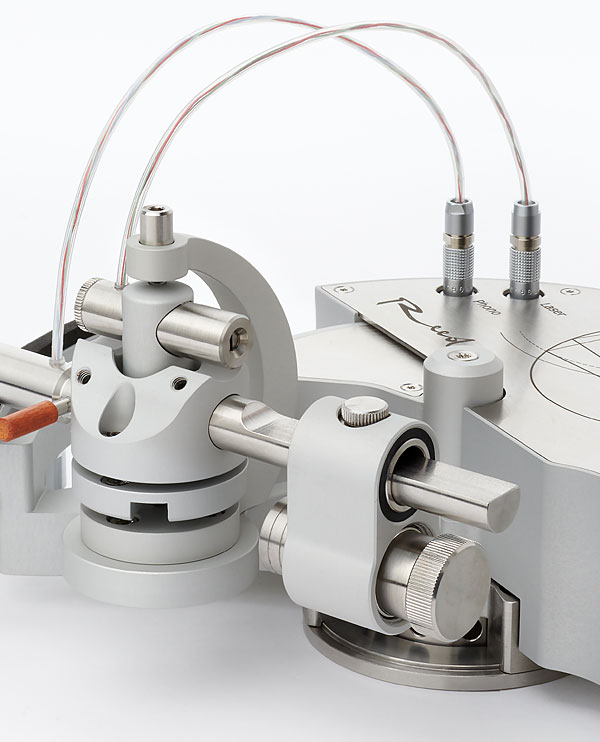
After those frustrating experiences taught me some lessons, I found setting up the arm somewhat straightforward. I say "somewhat," because the alignment tool took some getting used to; the instructions simply say "use it." With a servo in play, you have to move the arm slowly across the arc; otherwise "overload" will cause the system to stop operating. Unless you are paying attention to the blinking LED next to Gort, you won't know that. Ultimately, I was able to set up the costly Ortofon MC Century cartridge without incident—and wowza, did it sound great with this arm/'table combo!
It sounded great, that is, when I remembered to turn the tonearm on.
A few listening sessions began with me thinking, "The player sounds weird today," until I realized I hadn't powered up the arm.
Then, after you power up the battery supply—a fully charged battery will power the arm for 15 hours—you have to activate the servo by pushing a button behind the Gort piece.Thereafter, the 5T operates like a standard tonearm, only better, arguably—and certainly with less hassle than your typical high-horizontal-moving-mass tangential tracker. The 5T's horizontally positioned pivot points, which control vertical movement, can each be adjusted to set azimuth to ±8°.
And the entire arm mechanism rides up and down on a threaded post, allowing precise ±0.2mm vertical tracking angle and stylus rake angle adjustment. In addition, the wooden arm tube is user-replaceable, which allows you to change the tonearm's effective mass or swap out cartridges premounted on extra tubes.
Stable, timbrally neutral sound I can't separate the arm's performance from the 'table's (I'd love to try the 5T on my Continuum Audio Labs Caliburn turntable), so let's talk about the combination.
The 1C and 5T did really well on the tap test—better than many "fancy feet"–equipped 'tables.
Tapping anywhere on the plinth produced the tiniest of "tinks," with no low-frequency component and no overhanging sound. Tapping on the HRS base produced a somewhat lower frequency "tink," but still nothing compared to the sounds produced on some more massive 'tables. I'd pulled out the Modern Jazz Quartet's European Concert (Atlantic SD 2-603) to show Ken Micallef for the video he recently shot of me for his YouTube channel.
Well-recorded in Sweden in 1960, the MJQ record provides a good test for image stability, transient clarity, bass extension, and soundstaging. All across side one, the Reed produced a consistently wide soundstage with stable, unwavering, and cleanly drawn three-dimensional images: John Lewis's piano, left channel; Milt Jackson's vibes, right; drummer Connie Kay and bassist Percy Heath, centerstage.
Over the decades I've played it, this difficult-to-reproduce record just keeps sounding better! Apparently, what I once thought were recording distortions in the piano and vibes were actually tracking issues—rendered virtually undetectable with the 5T in place.
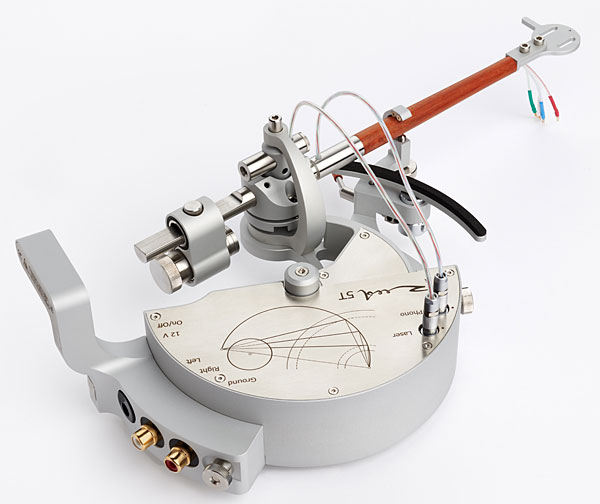
On "I Should Care," Kay's cymbals had the ideal sharp, metallic ring and natural sizzle and decay.
The snare was equally snappy, with no overhang, each hit cleanly evaporating into black. Percy Heath's compact bass lines combined well–articulated-and-textured transient "pop" with generous "live space" sustain and decay that produced tuneful, nimble rhythmic swing—all this on a record that can show sloppy low-frequency overhang on lesser 'tables and arms. Images were properly sized, well-focused and neither bloated nor diffuse—ill effects some air-bearing tangential trackers create.
The 5T extracted musical fun from every record I played, plus a sense of ease and relaxation. It did everything well. Its overall performance was, top to bottom, timbrally well-balanced, "musical," and artifact-free: sweet yet detailed and open and airy like the 3P I reviewed a few years ago.
This tangential tracker especially excelled in soundstage stability and expansiveness, all across the record surface, consistently. Tracking-error distortions are not heard as "distortion" in the classic sense: With a properly-set-up pivoted arm, there's no "buzzing" or gross mistracking; if you hear that, you've made a serious setup mistake.
Rather, it's heard to a great degree as second-order harmonic "fuzziness," particularly at soundstage center. On this familiar live recording, I noticed an unusually well-balanced curtain of applause spread across the stage. Image focus and especially transient clarity were consistent throughout the soundstage and across the entire record side.
Playback on the reference SAT CF1-09 arm (using the Ortofon MC Anna Diamond cartridge—which, while not identical, is very similar to the MC Century), which alone costs more than the Reed 1C and 5T combined, generally produced a more subtle picture, yet it surprised by better expressing the vibe's shimmering, mesmerizing vibrato, which the Reed somewhat shortchanged.
With the SAT setup, the entire picture hung onto the decay far longer, and the bass weight was no contest—SAT for the easy win. The sheer bottom-end grip and force produced a deeper stage that placed the drum kit farther back and behind the bass.
That bottom-end grip also added hall-sound perspective and brought greater power to Heath's bass lines, particularly on the Arco bass that ends the track.
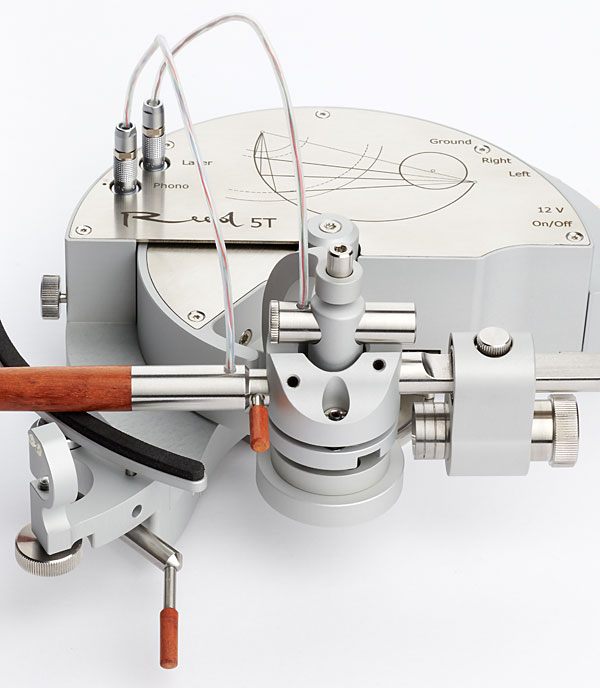
For a serious test of the Reed 5T's efficacy, I used Fiesta in Hi-Fi (Mercury SR 90134), side one of which is cut almost to the label.
The SAT arm's geometry uses Löfgren alignment, though that assumes that the innermost groove radius is 75mm, which is optimistic: On this record, I measured modulated grooves to within 56mm of the record center!
Beyond the second null point, which falls at 80.66mm, distortion rises rapidly. Is it audible?
The side ends with Ron Nelson's rousing "Savannah River Holiday," and here again there was no contest, but with a different winner.
The Reed 5T remained focused to the very end of the side, with a wide stage upon which each instrument was cleanly delineated.
You'd never know you were at the end of the side, especially one cut so close to the label. It was remarkable, and far superior to more typical tangential trackers, which usually produce "tail wagging the dog" spatial wavering.
The SAT produced in the post-null space a narrower stage on which the instruments were soft and smeared. It only lasted a short time and was neither unpleasant nor distorted-sounding. It just seemed degraded compared to most of the side.
The 5T was clearly superior here.
That experience drove me to play the test pressing of the D2D Bruckner 7 I've previously written about, which should be out by the time this column is published.
The Reed 1C/5T combo killed (in the good sense) on this simply miked record, producing airy, smooth violins and violas and giving proper weight to the double basses, rumbling timpani, and, at the end of the first movement, a majestic presentation of the horns—plus a grand sense of the Berlin Philharmonie space.
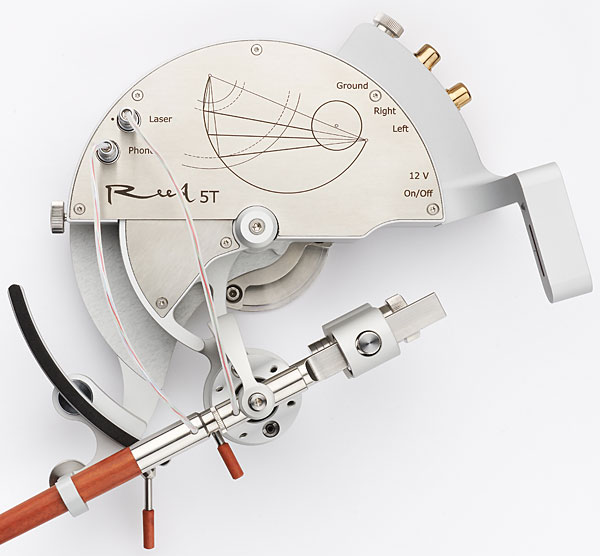
Conclusion For less than $40,000, you can get the combination of the Reed Muse 1C—a handsome, well-designed, dual-friction-drive (or belt-drive), high-performance turntable—and the 5T tonearm, an ingeniously designed, tangential-tracking arm that delivers what it promises for playback—spatially, dynamically, and timbrally.
The 1C plays at accurate and consistent speed. It is quiet and well-isolated from the outside world, and it passes the "tap test" better than many other turntables do.
As for the 5T tonearm, I'd say you can get better bottom-end performance from less costly arms such as Graham's Phantom Elite, perhaps because the Reed arm isn't grounded to the plinth but is instead riding on the tangential merry-go-round. But what the 5T arm does so well—especially spatially and without the usual tangential hassles—makes it special, an object of desire for vinyl lovers lucky enough to hear it.
Writing instruction manuals might not be his forte, but Mr. Triukas has designed a brilliant turntable and tonearm in the 1C and 5T, respectively, and somehow manages to produce them for a price that won't break many high-end banks.
Περισσοτερες πληροφοριες και τιμες εδω
https://www.chameleonracks.gr/Reed%20turntable%20/REED-5T-en
https://www.chameleonracks.gr/Reed%20turntable%20/MUSE-1C-en

